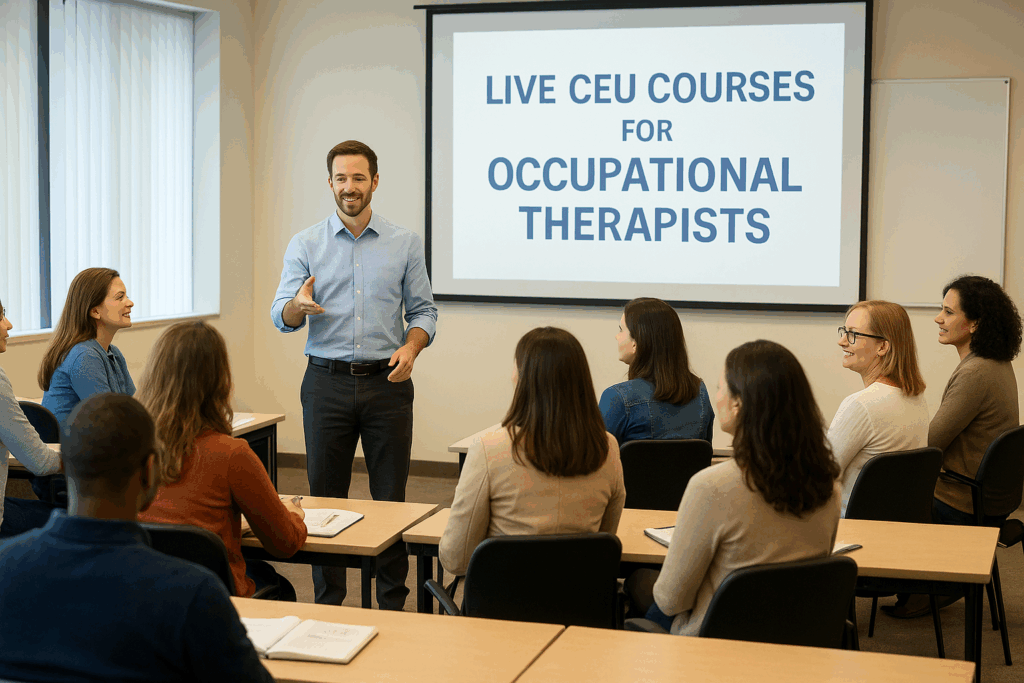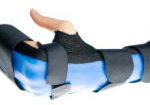Cours de formation continue en direct pour ergothérapeutes : le guide ultime de l'apprentissage et de la croissance
Classé sous Non classé
Introduction aux cours CEU en direct
La formation continue est une pierre angulaire du développement professionnel dans le domaine des soins de santé et, pour les ergothérapeutes, ce n’est pas seulement une recommandation, c’est souvent une exigence. Cours de formation continue en direct pour les ergothérapeutes offrent l'équilibre parfait entre apprentissage structuré, interaction entre pairs et formation pratique qui manque souvent aux modules en ligne à rythme libre.
Que vous soyez un nouveau diplômé cherchant à perfectionner vos compétences ou un professionnel chevronné cherchant à rester au courant des dernières techniques, les cours CEU en direct peuvent vous aider à élargir vos connaissances et à renforcer votre confiance dans la pratique clinique.

Que sont les cours CEU en ergothérapie ?
CEU signifie Unités de formation continueCes formations permettent aux ergothérapeutes de se tenir informés des dernières recherches, des techniques de traitement et des meilleures pratiques. Chaque formation vous permet d'obtenir des crédits utilisables pour le renouvellement de votre permis d'exercice.
Pourquoi les ergothérapeutes ont besoin d'une formation continue
L'ergothérapie évolue constamment grâce à de nouvelles interventions fondées sur des données probantes. Les UFC permettent aux ergothérapeutes de :
- Restez conforme aux lois sur les licences.
- Améliorez les résultats des patients grâce à des pratiques mises à jour.
- Explorez des domaines spécialisés tels que la pédiatrie, la gériatrie ou la thérapie de la main.
- Améliorer la crédibilité professionnelle et les opportunités de carrière.
Avantages des cours de formation continue en direct pour les ergothérapeutes
Interaction en temps réel avec les instructeurs
Contrairement aux cours préenregistrés, les CEU en direct vous permettent de poser des questions et de recevoir un retour immédiat, ce qui approfondit votre compréhension de concepts complexes.
Opportunités de réseautage avec des pairs
Ces cours réunissent souvent des thérapeutes de différentes spécialités, créant des opportunités d’échanger des idées, de partager des défis et même de collaborer professionnellement.
Développement des compétences pratiques
Pour les techniques qui nécessitent de la pratique, comme la thérapie manuelle, l’attelle ou l’intégration sensorielle, les cours en direct offrent des démonstrations pratiques inestimables.
Comparaison des options de CEU en direct et en ligne
Flexibilité et accessibilité
- CEU en ligne:Étudiez à tout moment, n'importe où.
- CEU en direct:Offrir une structure et une responsabilité.
Différences de coût et de valeur
Bien que les options en ligne puissent être moins chères, les cours en direct offrent souvent une valeur ajoutée en termes de maîtrise des compétences et de mentorat direct.
Quelle option correspond à votre style d’apprentissage ?
Si vous aimez l’interaction, le feedback et les démonstrations pratiques, les CEU en direct sont le meilleur choix.
Sujets populaires des cours de formation continue en direct pour ergothérapeutes
Thérapie de la main et motricité fine
Formation spécialisée en attelles, rééducation des membres supérieurs et récupération de la motricité fine.
Ergothérapie pédiatrique
Apprenez des stratégies pour travailler avec des enfants qui ont des retards de développement, de l’autisme ou des troubles du traitement sensoriel.
Réadaptation gériatrique
Acquérir une expertise en matière de prévention des chutes, de soins aux personnes atteintes de démence et d’entraînement à la mobilité.
Réadaptation neurologique et cognitive
Restez informé sur la réadaptation après un AVC, la récupération après un traumatisme crânien et les interventions sur la mémoire.
Comment choisir le bon cours CEU
Accréditation et exigences de l'État
Vérifiez toujours que le cours est reconnu par le conseil d’agrément de votre État.
Expertise et qualifications de l'instructeur
Recherchez des instructeurs ayant une expérience clinique concrète et une solide formation académique.
Avis sur les cours et commentaires des anciens élèves
Vérifiez les commentaires des anciens participants pour garantir la qualité et la pertinence.
Meilleures plateformes proposant des formations CEU en direct pour les ergothérapeutes
- AOTA (Association américaine d'ergothérapie) – La référence absolue en matière d’enseignement en ergothérapie.
- HandTherapyAcademy.com – Connu pour ses sessions interactives de haute qualité.
- Programmes universitaires et hospitaliers – Proposent souvent des formations de pointe, appuyées par la recherche.
Apprenez-en davantage sur l’accréditation CEU sur le site officiel de l’AOTA.
Conseils pour optimiser l'apprentissage dans les cours CEU en direct
- Préparez-vous avant d'y assister – Révisez le matériel de cours à l’avance.
- Prendre des notes efficacement – Utilisez des puces et mettez en évidence les techniques clés.
- Appliquer les connaissances dans la pratique quotidienne – Renforcer l’apprentissage en appliquant immédiatement de nouvelles stratégies avec les patients.
FAQ sur les cours de formation continue en direct pour les ergothérapeutes
Q1. De combien d'UFC les ergothérapeutes ont-ils besoin par an ?
Les exigences varient selon l’État, mais la plupart nécessitent entre 12 et 24 heures de formation continue par an.
Q2. Les formations CEU en présentiel sont-elles plus chères que celles en ligne ?
Oui, en général, mais l’investissement est souvent rentabilisé grâce à la maîtrise des compétences et au réseautage.
Q3. Les formations CEU en direct peuvent-elles être comptabilisées pour le renouvellement de la licence ?
Absolument, à condition qu’ils soient accrédités par un organisme reconnu comme l’AOTA.
Q4. Comment trouver les prochains ateliers de formation continue en direct près de chez moi ?
Consultez les associations professionnelles, les événements universitaires et les plateformes de formation continue.
Q5. Les employeurs remboursent-ils les frais de formation CEU ?
De nombreuses organisations de soins de santé proposent un remboursement. Renseignez-vous toujours auprès de votre service des ressources humaines.
Q6. Puis-je combiner des formations en présentiel et en ligne pour répondre à mes besoins ?
Oui, la plupart des conseils acceptent un mélange, mais vérifiez les directives spécifiques à chaque État.
Conclusion : Faites progresser votre carrière grâce aux cours CEU en direct
Cours de formation continue en direct pour les ergothérapeutes Les formations en présentiel sont bien plus qu'une simple exigence : elles constituent un puissant outil de développement, d'innovation et d'avancement professionnel. Elles offrent des opportunités de réseautage, d'acquisition de compétences pratiques et un retour d'information en temps réel que les options en ligne ne peuvent pas toujours égaler. En investissant dans une formation en présentiel, vous remplissez non seulement les conditions d'obtention de votre licence, mais vous renforcez également votre impact professionnel.
Plus à lire
Quelle est l’incidence des troubles musculo-squelettiques au niveau du coude, de l’épaule et du cou après des blessures à la main et à l’avant-bras ?
Winiarski, LM, Livoni, JD, Madsen, PV, Rathleff, MS et Larsen, P. (2021). Plaintes musculo-squelettiques concomitantes au niveau des coudes, des épaules et du cou après des blessures ou affections courantes de la main et de l'avant-bras : une étude transversale auprès de 600 patients. Journal of hand thérapie : journal officiel de l'American Society of Hand Therapists, 34(4), 543-548. https://doi.org/10.1016/j.jht.2020.05.002 Le maigre : le…
En savoir plusLa prise d'acide alpha-lipoïque pendant 40 jours après une chirurgie du canal carpien peut diminuer le risque de développer des douleurs piliers.
Filippo, B., Granchi, D., Roatti, G., Merlini, L., Sabattini, T. et Baldini, N. (2017). Acide alpha-lipoïque après décompression du nerf médian au niveau du canal carpien : un essai contrôlé randomisé. Le Journal de Chirurgie de la Main, 4, 236-42. The Skinny – Une étude contrôlée randomisée en double aveugle a été réalisée. Soixante-quatre patients ont été répartis au hasard en deux groupes après une médiane…
En savoir plusQuand devriez-vous utiliser une attelle statique progressive en thérapie de la main ?
Fleurs, K. (2002). Une hiérarchie de décision proposée pour attiser l'articulation rigide, en mettant l'accent sur les paramètres d'application de la force. Journal de thérapie de la main, 15, 158-162. The Skinny- L'article propose une hiérarchie de décision pour déterminer quand vous devez appliquer une orthèse statique progressive ou dynamique. La hiérarchie décisionnelle utilise un test de semaines modifié (MWT). Le…
En savoir plusLa rééducation des tendons fléchisseurs au 21e siècle : une revue systématique
Neiduski, RL et Powell, RK (2019). Rééducation des tendons fléchisseurs au 21e siècle : une revue systématique. Journal de thérapie de la main, 32, 165-174. The Skinny L'objectif de l'étude était de déterminer s'il existait des preuves appuyant un type de programme d'exercice. Les programmes d'exercices examinés incluent le lieu et les prises, les exercices passifs précoces ou…
En savoir plusInscrivez-vous pour recevoir des mises à jour directement dans votre boîte de réception !
Inscrivez-vous avec nous et nous vous enverrons régulièrement des articles de blog sur tout ce qui concerne la thérapie des mains, des notifications chaque fois que nous mettons en ligne de nouvelles vidéos et tutoriels, ainsi que des documents, des protocoles et d'autres informations utiles.






